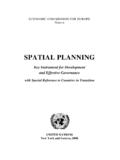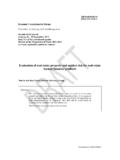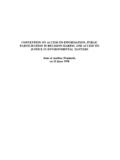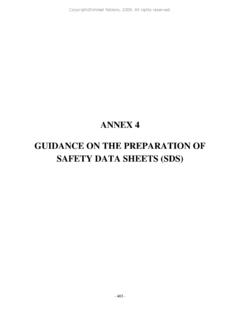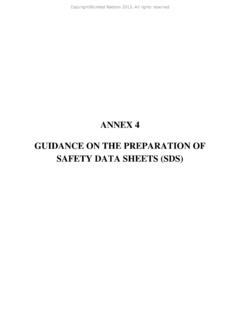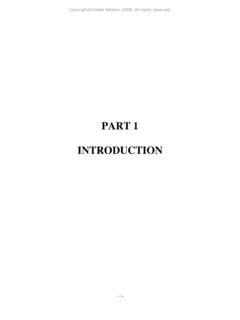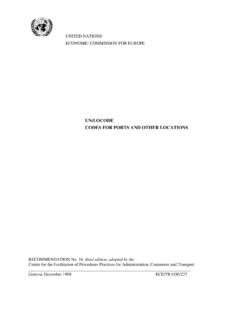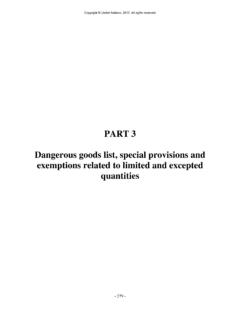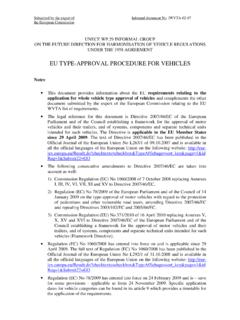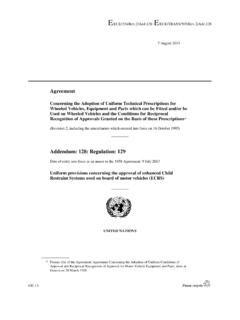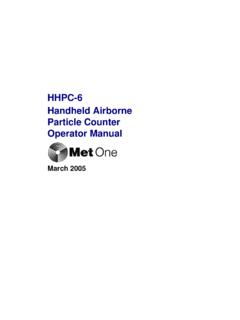Transcription of The AVL Particle Counter: APC 489 - UNECE Homepage
1 AVL Particle counter : apc 489 Experience from VPR and PNC validations2 Giechaskiel, December 2011, JRCO utlineIntroductionPNC calibration / validation / checkVPR calibration / validation / checkConclusions3 Giechaskiel, December 2011, JRCPast and presentAVL has reported some issuesPNCL inearityDriftCAST and Emery oil differences at 23 and 41 nmVPR Calibration proceduresNew topicsValidation procedures and on-site checks4 Giechaskiel, December 2011, JRCO utlineIntroductionPNC calibration / validation / checkVPR calibration / validation / checkConclusions5 Giechaskiel, December 2011, JRCPNC (CPC) calibration / validation setupPrimary methodSecondary method(used by AVL)6 Giechaskiel, December 2011, JRCAVL experience Non-linearity has been reported for the 3790 (and 3772) AVL experience from validations of >40 3790s shows that the non-linearity is usually within +/-3% (or +/-7% with 2 ).
2 This means that max and min concentrations differ by 3% or 7% sometimesGiechaskiel and Bergmann 2011, JAS, 42, 195-2037 Giechaskiel, December 2011, JRCAVL experience Emery oil and CAST have differences Approximately at 23 nm and at 41 nm This difference should be taken into account in the validation of the CPCs The >40 validations confirmed this8 Giechaskiel, December 2011, JRCAVL validationsSerial number70831244 Test Aerosol: Soot (CAST)Date4-May-11with thermal pre-treatmentInlet Flow (Volumetric)UnitsLow Limit High Flow and PressureUnitsLow Limit High Limit20 Room Temperature C--28 Room Relative Temperature Temperature Temperature Temperature Drop across Drop across Detection & Concentration Linearity Test ResultsUnitsLow Limit High Particle Counting Efficiency-38%62% Particle Counting Efficiency-90% Test: Slope (up to 10000p/cm )-90%110% of Regression (R ) k factor (taken into account) Count TestUnitsLow Limit High Average over 3 Minutesp/cm Response: CPC vs.
3 Calibrated CPC 3790 UnitsLow Limit High p/cm CPC Concentration% Diff-10%10% p/cm CPC Concentration% Diff-10%10% p/cm CPC Concentration% Diff-10%10% p/cm CPC Concentration% Diff-10%10% p/cm CPC Concentration% Diff-10%10%TSI CPC Model 3790 Certificate of Validationk factor is includedno correction for material appliedDecision has to be made for pass / fail criteriacorrections appliedslope, the most important value9 Giechaskiel, December 2011, JRCD egrading over time2 out of 5 drifted (40%)The reason is the wick (where the super-saturation is achieved)The critical point: No light indicator identified this degradingGiechaskiel and Bergmann 2011, JAS, 42, 195-203 New results:15 out of 41 drifted (37%)10 Giechaskiel, December 2011, JRCPNC (CPC) on site checkSoot generatorRef PNC (d50=23 nm)Linearity checkGiechaskiel and Bergmann 2012, submitted SAE World Congress11 Giechaskiel, December 2011, JRCPNC polydisperse check (theoretically)correction factor is needed12 Giechaskiel, December 2011, JRCE quivalency of mono- and polydisperse checks (experimentally)CMD=75 nm90 nm13 Giechaskiel, December 2011, JRCC onclusions PNCL inearity of PNCs is very important.
4 Although the results should be within +/-10%, for a specific PNC the difference between low and high concentrations should be within +/-5% ( from -10% up to 0%). From 41 CPC validation only a few had a non-linearity issue of 7%, the rest <3%.Emery oil and CAST have different counting efficiencies. Differences are and for 23 and 41 nm particles respectively. This should be taken into account for the validationsDrift of PNCs 5-10% every 3-6% is common. From 41 CPC validations 15 (37%) drifted >20%.Validations check PNC: flow, 23 nm, counting efficiencies, linearity and slope. k factor should be taken into account or not? The critical point for PN results is the slope. Flow? 23 nm? +/-10%14 Giechaskiel, December 2011, JRCC onclusions PNCThe polydisperse on-site check was proven to be equivalent with the monodisperse calibration / validationA soot generator that produces a size distribution with median around 70 nm and a reference PNC are only issue remains the results that have been conducted with failed devices15 Giechaskiel, December 2011, JRCO utlineIntroductionPNC calibration / validation / checkVPR calibration / validation / checkConclusions16 Giechaskiel, December 2011, JRCVPR calibration setupAVL setup CAST (or mini CAST) Thermal pre-treatment (350 C) One neutralizer upstream (370 MBq)
5 PCRF = Nin/ Nout Reference PNC for monitoring stability of Generator Upstream / downstream same flow rates, correction for PNC inlet pressures PNCs with d50=10nmMixing Orifice or ChamberMakeup +3 P/CCESCESCC ondensationParticle CounterParticle +3 P/CCESCESCC ondensationParticle CounterThermal pre)treatmentPNCPNCG iechaskiel et al. SAE 2009-01-1115 Giechaskiel et al. 2010, MST, 21, 04510217 Giechaskiel, December 2011, JRCC alibration set upFilterMixing Orifice or ChamberMakeup +3 P/CCESCESCC ondensationParticle CounterParticle +3 P/CCESCESCC ondensationParticle CounterThermal pre)treatment & DilutionPNCmonPNCRefFilterMixing Orifice or ChamberMakeup +3 P/CCESCESCC ondensationParticle CounterParticle +3 P/CCESCESCC ondensationParticle CounterThermal pre)treatment & DilutionPNCmonPNCRefMFC18 Giechaskiel, December 2011, JRCP article Generator (Mini CAST)System under calibrationDMA and PNCsVPR calibration setup19 Giechaskiel, December 2011, JRCVPR calibration.
6 RepeatabilityRepeatability95% of calibrations within 6%Recalibration of five VPRs (APCs from AVL) units after two days (no modification), after 5-11 months (guidance rods and springs were changed) and after 9 months (rotating disk also changed).Error bars show 2 standard et al. 2010, MST, 21, 04510220 Giechaskiel, December 2011, JRCC omparison of AVL s calibration linesCS: Repair centerFLZ 1: Production 1 FLZ 2: Production 2 Three APCs were calibrated either at the CS (repair center) or the production lines 1 (FLZ 1) and 2 (FLZ 2). The mean differences were 1% and the 95% of the differences within 4%.21 Giechaskiel, December 2011, JRCC omparability of APCs Two well calibrated systems of the same manufacturer (AVL) on average <4% difference 95% of differences within 10%Comparison of two PN systems (APCs from AVL) both connected to the CVS for one heavy duty engine (different test cycles) and two different APCs for four different light duty vehicles (for the NEDC cycle).
7 HD=Heavy Duty, LD=Light Duty, SCR=Selective Catalytic Reduction for NOx, DPF=Diesel Particulate Filter, G-DI=Gasoline Direct Injection. Giechaskiel et al. 2010, MST, 21, 04510222 Giechaskiel, December 2011, JRCV alidationsRecalibration of five VPRs (APCs from AVL) units after many months of use at the CVSE rror bars show 2 standard APCs36 APCsno trend23 Giechaskiel, December 2011, JRCVPR on site checkSoot generator with venturi (CMD=50 nm)Reference PNC (d50=23nm)Check of PCRF <1000 Relative check for rest PCRFs 24 Giechaskiel, December 2011, JRCT heoretical polydisperse PCRF25 Giechaskiel, December 2011, JRCR elative checks of PCRFs26 Giechaskiel, December 2011, JRCVPR conclusionsAVL calibration procedure (CAST with thermal pre-treatment, one neutralizer, monitor PNC, single PNC method with d50=10 nm).
8 The thermal pre-treatment is importantAVL calibration procedure has +/-6% uncertainty (95% of calibrations). Comparison of two APCs from the the CVS should have less than 5% differences (+/-10%, 95% of the comparisons)Validation of 60 units showed that there was no drift and The uncertainty is +/-10% for low PCRFs (<2000) but can reach 30% at very high PCRFs (20000)On site PCRF check is possible with a reference PNC (d50=23 nm). The generated polydisperse size distribution should have a median of 50 higher PCRFs the relative check is recommended (to avoid the 30% uncertainty)How previous results from failed VPRs are treated?
